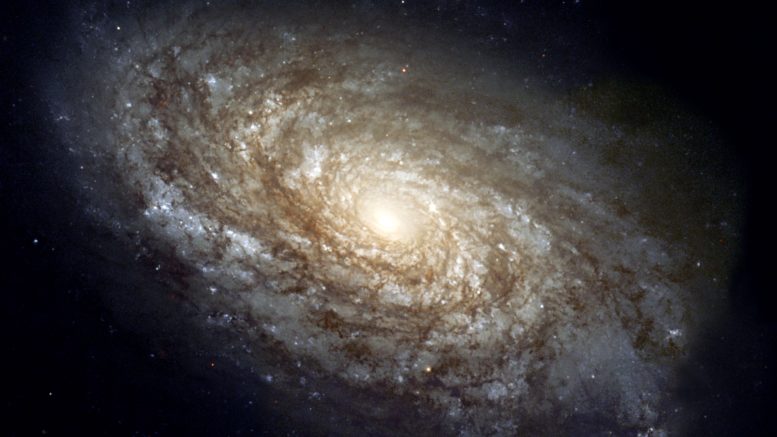Before we get started talking about the types of galaxies, we should define the term and look at what exactly makes up a galaxy. A galaxy is a gravitationally bound system of stars, stellar remnants, interstellar gas, dust, and dark matter.
The word galaxy is derived from the ancient Greek term for our own galaxy, galaxias, which means milky circle. According to Greek legend, the Milky Way is so named because the dusty band of stars spreading across the night sky was thought to be milky spray from Zeus’ breastfeeding wife.
The basis for galaxy classification is based in galactic appearance or morphology. This means that astronomers group galaxies by shape, and although there are many different types of galaxies, most fall into one of three main categories: spiral, elliptical or irregular.
Galaxy Types
Spiral Galaxy
The Spiral Galaxy was first described by Edwin Hubble in 1936, most spiral galaxies consist of a flat, rotating disk containing stars, gas and dust, and a central concentration of stars known as the bulge. There are 4 types of spiral galaxies, which includes the Milky Way.
- S0 galaxies have a bright nucleus but have no spiral arms.
- Sa galaxies have spiral arms that are wound tightly around the nucleus
- Sb galaxies are an intermediate type of spiral typically has a medium-sized nucleus. Its arms are more widely spread than those of the Sa variety and appear less smooth.
- Sc galaxies have arms that are wound much more loosely.
BARRED SPIRAL GALAXY
Barred spiral galaxies share the same features and functions as regular spiral galaxies, but they also have a bar of bright stars that lie along the center of the bulge, and extend into the disk. At the center of these galaxies, the stars have little activity and contains mostly older, red stars. The bar and arms have lots of activity.including star formation. There are several types of barred spiral galaxies.
- SBa have tight bars that correspond to tight galaxies.
- SBb have longer bars and less tight galaxies
- SBc have the longest bars and are the least tight galaxies of this. type.
ELLIPTICAL GALAXY
Elliptical galaxies can be recognized by their elongated spherical shape and their lack of nucleus or bulge at the center. Although there is no nucleus, the galaxy is still brighter in the center and becomes less bright toward the outer edges of the galaxy. Stars, gases and other materials are spread throughout the elliptical galaxy. An elliptical galaxy can be nearly round or long and cigar shaped.
It is believed that a great deal of the mass in an elliptical galaxy is due to the presence of a central black hole. These galaxies have very little activity and contain mostly old stars of low mass, because there aren’t the gasses and dust needed to form new stars.
IRREGULAR GALAXY
An irregular galaxy is a galaxy that does not have a distinct regular shape, unlike a spiral or an elliptical galaxy. Irregular galaxies do not fall into any of the regular classes of the Hubble sequence, and they are often chaotic in appearance, with neither a nuclear bulge nor any trace of spiral arm structure. These galaxies are moving outward and away from the center of the universe. These type of galaxies are divided into two classifications.
- Im galaxies can show a trace of the spiral galaxy arms, and are the more common of the 2 types of irregular galaxies
- IO galaxies can be more chaotic in nature.
Now you know more about the different galaxy types! Knowing the shape of the galaxy does help understand the evolution and potential composition and size of a galaxy. Galaxies are not structures that are stationary and do indeed move in space, as galaxies do merge and form larger structures such as galaxy clusters and galaxy superclusters. Come back next week as we take a look at galactic clusters and galactic superclusters.

Leave a comment